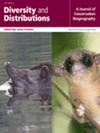Trait-Based Indicators of Marine Communities' Sensitivity to Climate Change and Fishing
Abstract
Aim
Overexploitation of wildlife and anthropogenic climate change are key drivers of global biodiversity loss. Investigating how these stressors interact and affect ecosystems is critical for conservation efforts. Following trait-based vulnerability assessments, we propose two community-level sensitivity indicators: climate change (SCC) and fishing pressure (SFP).
Location
Cantabrian and Spanish Mediterranean Sea.
Methods
Both indicators were calculated for 246 fish and megabenthos species, sampled during 1994–2019 in two areas with contrasting levels of warming and fishing pressure. Indicator calculation was based on traits that, according to existing evidence, can be linked to (1) sensitivity to climate change (scored as SCC) and (2) sensitivity to fishing pressure (SFP). Using each species' sensitivity scores, and abundance data from the surveys, we explored whether these areas' community-level sensitivity has changed spatiotemporally in line with the expected functional responses to these predominant pressures.
Results
Although both regions have warmed, the Spanish Mediterranean is far more so. Its community-level SCC has decreased, reflecting a shift in composition from warm-sensitive to warm-affinity species. In contrast, sensitivity dynamics in the Cantabrian Sea varied, with warm-sensitive species increasing in deeper areas and decreasing towards the inner Bay of Biscay. Decreasing fishing pressure in both regions paralleled an increase in sensitivity in the Cantabrian Sea, particularly among slow-reproducing, longer-lived species. The Spanish Mediterranean, however, showed a relative loss of fishing-sensitive, long-lived species and both cases showed spatial heterogeneity.
Main Conclusions
Associations are revealed between SCC and SFP, and climate change and fishing, respectively. We conclude that SCC and SFP are valuable indicators of the community-level sensitivities to these two pressures, and we discuss the limitations and assumptions that underly this and other trait-based approaches. We recommend wider usage of this kind of indicators, which could be applied globally to understand risks of marine communities to climate change and fishing.


 求助内容:
求助内容: 应助结果提醒方式:
应助结果提醒方式:


